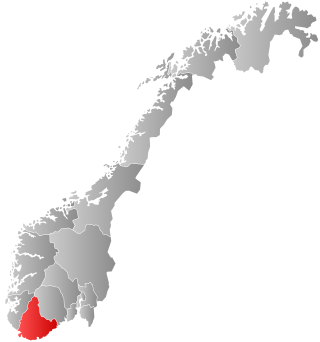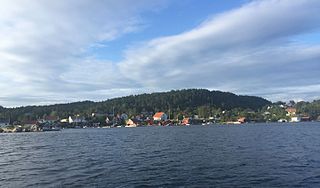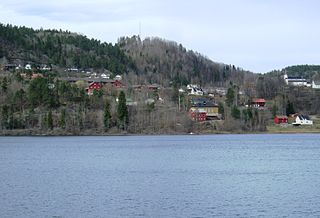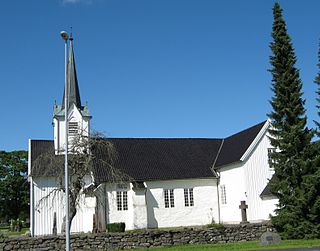
Sokndal is the southernmost municipality in Rogaland county, Norway. It is located in the traditional district of Dalane. The administrative centre of the municipality is the village of Hauge. Other villages in Sokndal include Li, Rekefjord, Sogndalsstranda, and Åna-Sira.

Kvam is a municipality in Vestland county, Norway. The municipality is located along the Hardangerfjorden in the traditional district of Hardanger. The administrative centre of the municipality is the village of Norheimsund. Other larger settlements in the municipality include Øystese, Bru, Ålvik, Tørvikbygd, Omastranda, and Mundheim. Historically, the municipality was named Vikør.

Hægebostad is a municipality in Agder county, Norway. It is located in the traditional district of Lister. The administrative centre of the municipality is the village of Tingvatn. Other villages in Hægebostad include Eiken, Haddeland, and Snartemo. The municipality encompasses the northern end of the Lyngdalen valley which follows the river Lygna.

Åseral is a municipality in Agder county, Norway. It is in the traditional district of Sørlandet. The administrative centre of the municipality is the village of Kyrkjebygda. Other villages in Åseral include Eikerapen, Kylland, Ljosland, and Åknes.

Søgne is a former municipality in the old Vest-Agder county, Norway. The municipality existed from 1838 until 2020 when it was merged with the municipalities of Songdalen and Kristiansand into the "new" Kristiansand municipality in what is now Agder county. It was located in the traditional district of Sørlandet, just outside of the city of Kristiansand. The administrative centre of the municipality was the hamlet of Tangvall. Hamlets and areas in Søgne include Ausviga, Eig, Høllen, Langenes, Lohne, Lunde, Ny-Hellesund, Trysnes, Vedderheia, Ålo, and Åros.

Nøtterøy is a former municipality in Vestfold county, Norway. The 61-square-kilometre (24 sq mi) island municipality existed from 1838 until its dissolution on 1 January 2018. The area is now part of Færder Municipality. The administrative centre was the village of Borgheim. Other villages in Nøtterøy included Årøysund, Buerstad, Duken, Føynland, Glomstein, Hårkollen, Kjøpmannskjær, Nesbrygga, Oterbekk, Skallestad, Skjerve, Strengsdal, Tenvik, Torød, Vestskogen, and Vollen. The whole northern part of the municipality was considered to be part of the city of Tønsberg metropolitan area.

Lardal is a former municipality in Vestfold county, Norway. The 278-square-kilometre (107 sq mi) municipality existed from 1838 until its dissolution in 2018. The area is now part of Larvik Municipality. The administrative centre was the village of Svarstad. The village of Steinsholt was also part of Lardal.

Hjartdal is a municipality in Telemark county, Norway. It is located in the traditional district of Upper Telemark and Aust-Telemark. The administrative centre of the municipality is the village of Sauland. Other villages in the municipality include Tuddal and Hjartdalsbygda.

Gjerstad is a municipality in Agder county, Norway. It is located in the traditional region of Sørlandet, in the southeastern part of the county, along the border with Telemark county. The administrative centre of the municipality is the village of Gjerstad. Other villages in the municipality include Ausland, Eikeland, Fiane, Gryting, Østerholt, Rød, Sundebru, and Vestøl.

Vegårshei is a municipality in Agder county, Norway. It is located in the traditional district of Sørlandet. The administrative center is the village of Myra. Other villages in Vegårshei include Mo and Ubergsmoen.

Birkenes is a municipality in Agder county, Norway. It is located in the traditional district of Sørlandet. The administrative centre of the municipality is the village of Birkeland, where about half the municipal population lives. Other villages in Birkenes include Ås, Engesland, Flakk, Håbbesland, Herefoss, Mollestad, Oggevatn, Rugsland, Senumstad, Søre Herefoss, Svaland, Tveide, and Væting.

Åmli is a municipality in Agder county, Norway. It is located in the traditional region of Sørlandet. The main population centre and administrative center is the village of Åmli which lies along the river Nidelva. Other villages in Åmli include Askland, Dølemo, Eppeland, Flaten, Hillestad, Homdrom, Lauveik, Nelaug, Øvre Ramse, Skjeggedal, Tveit, Vehus, and Ytre Ramse.

Iveland is a municipality in Agder County, Norway. It is located in the traditional district of Setesdal. The administrative centre of the municipality is the village of Birketveit. Other villages in the municipality include Bakken, Skaiå, and Vatnestrøm.

Bykle is a municipality in Agder county, Norway. It is located in the traditional district of Setesdal. The administrative centre of the municipality is the village of Bykle. Other villages in Bykle municipality include Berdalen, Bjåen, Breive, Hoslemo, Hovden, and Nordbygdi. Bykle was established as a municipality on 1 January 1902 when it was separated from the municipality of Valle.

Vestre Moland is a former municipality in the old Aust-Agder county in Norway. The administrative centre of the municipality was the village of Møglestu where the Vestre Moland Church is located. The 103-square-kilometre (40 sq mi) municipality existed from 1838 until 1962 when it was merged into the municipality of Lillesand. Today, the area of Vestre Moland covers the northern part of the present-day municipality of Lillesand in Agder county.

Våle is a former municipality in Vestfold county, Norway. The 82-square-kilometre (32 sq mi) municipality existed from 1838 until its dissolution in 2002. The area is now part of Tønsberg Municipality. The administrative centre was the village of Kirkevoll. Other villages in the rural, agricultural municipality included: Brekkeåsen, Rånerudåsen, Svinevoll, Sørby, and Gretteåsen.

Høvåg is a former municipality in the old Aust-Agder county in Norway. The 77 km2 (30 sq mi) municipality existed from 1865 until its dissolution in 1962. It was located in the southern part of the present-day municipality of Lillesand which is now in Agder county. The administrative centre of the municipality was the village of Høvåg where the Høvåg Church is located. Old coastal settlements in Høvåg include Ulvøysund, Gamle Hellesund, Skottevik, Kjøbmannsvig and Åkerøyhamn. The village of Høvåg is located midway between the towns of Lillesand and Kristiansand.

Tromøy is a former municipality in the old Aust-Agder county in Norway. The 30-square-kilometre (12 sq mi) municipality existed from 1878 until its dissolution in 1992. The municipal area is now part of the municipality of Arendal in Agder county. The administrative centre was the village of Brekka, where the historic Tromøy Church is located. The municipality encompassed all of the island of Tromøya as well as many smaller surrounding islands such as Merdø, Gjesøya, Skilsøy, and Tromlingene.

Hisøy is a former municipality in the old Aust-Agder county in Norway. The 10-square-kilometre (3.9 sq mi) municipality existed from 1881 until 1992 when it was merged into the municipality of Arendal in what is now Agder county. At the time of its dissolution, it was the smallest municipality in the whole county. The municipality encompassed the islands of Hisøya, Gjervoldsøy, Havsøya, Ærøya, Store Torungen, Lille Torungen, and several other small, unpopulated islands. The administrative centre was the village of Kolbjørnsvik on Hisøya island.

Øyestad is a former municipality in the old Aust-Agder county in Norway. The 96-square-kilometre (37 sq mi) municipality existed from 1838 until 1992, when it was merged into the present-day municipality of Arendal, which is now located in Agder county. At the time of its dissolution, the municipality of Øyestad encompassed most of the coastline between the towns of Grimstad and Arendal, along with the forested areas along the Nidelva river heading inland. Back in 1838, however, the municipality was far larger in size. The administrative centre was the village of Bjorbekk near the Bjorbekk Church.































